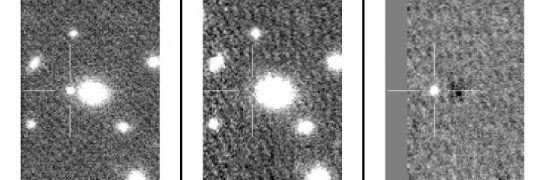Amateurs Spot Supernova Star Explosion For Space Scientists Studying Universe
A star exploded before the time of the dinosaurs, and average people just helped space scientists find it.
The stellar explosion called a supernova is 970 million light years away, so we are just seeing it now as it was 970 million years ago — well before dinosaurs dominated Earth. Australian National University scientists have been searching for supernovas and asked the public for help. Hundreds signed up, and, the university said, two online volunteers from Europe recently helped them spot one galaxy’s supernova. After the Belgian woman and Scottish man alerted the team, the scientists aimed a telescope at it to confirm what the object was in just a day’s time.
Read: Is This Bright Spot a Supernova or a Black Hole?
“This is the exact type of supernova we're looking for … to measure properties of and distances across the universe,” one of the lead researchers, Brad Tucker, said in the ANU statement.
Supernovas can potentially help us understand our universe because of how much light they produce.
“These explosions are insanely bright,” Tucker explained in a video (below). “So if you can imagine a lightning bolt, imagine a powerful lightning bolt, and then imagine a hundred million billion billion billion of them. That is one star when it blows up.”

Those star explosions are relatively rare on the scale of a single human life on Earth, as opposed to a universe that is billions of years old. As famous astrophysicist Neil deGrasse Tyson has pointed out, when describing a supernova explosion as his second favorite way to die in space (his favorite is a black hole), a supernova might happen once per century in each galaxy. It’s the biggest kind of space explosion there is, and it happens when a star accumulates too much mass, either because it is so old or, in binary star systems, where two stars orbit the same point, because it has gobbled up matter from its companion.
When scientists look at these exploding stars, the intense light coming off them is “a candle to measure the universe as a whole,” Tucker explained. Measuring how the light source fades over a distance — by looking at how much light is cast upon other objects, for example — tells you how far that distance is. From those measurements, scientists can determine “how the universe is growing and what it’s doing.”
Read: How a Black Hole vs. a Supernova Murders You in Space
But part of the problem in finding a supernova is manpower. The team needs a pair of eyes checking telescope images to know what to follow up. With the ANU program that leverages amateur astronomers and space enthusiasts, there are many more eyes doing that check work. Once an object is flagged, the scientists can enlist a telescope to better observe it and find out if it truly is a supernova.
So far, the project has identified dozens of possible supernovas.
“In the first 24 hours we had over 30,000 classifications,” another lead researcher, Anais Möller, said. “We’ve almost reached 40,000 classifications, with more than 1,300 images classified, since the launch of our project.”
© Copyright IBTimes 2024. All rights reserved.



















